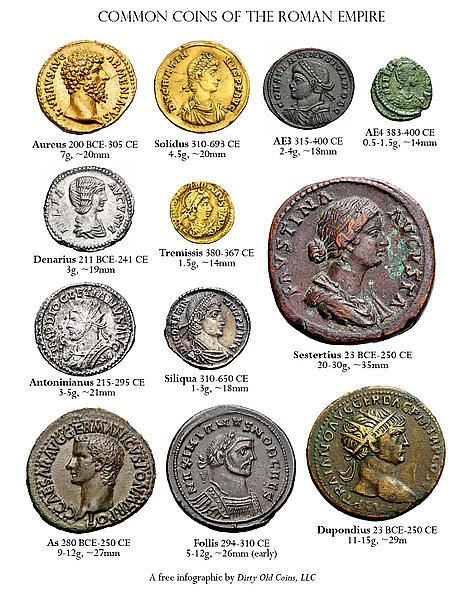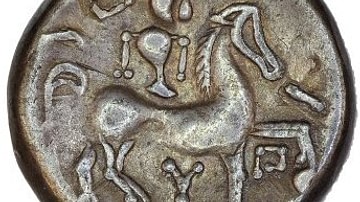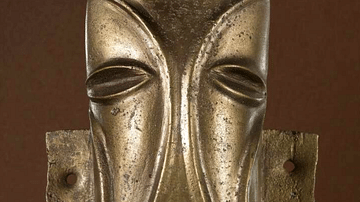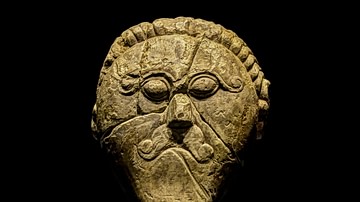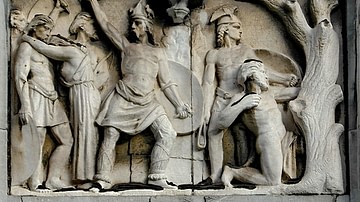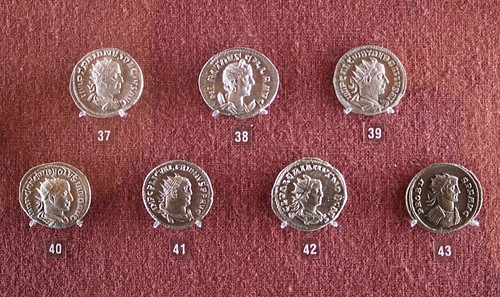
Roman coins were first produced in the late 4th century BCE in Italy and continued to be minted for another eight centuries across the empire. Denominations and values more or less constantly changed but certain types such as the sestertii and denarii would persist and come to rank amongst the most famous coins in history.
Roman coinage, as in other societies, represented a guaranteed and widely recognised value which permitted an easy exchange of value which in turn drove both commerce and technology development as all classes could work to own coins which could be spent on all manner of goods and services. Even more significantly, large and identical payments could now be easily made which made possible a whole new scale of commercial activity. Coins also had a function as a vehicle to spread the imagery of the ruling class as coinage was the mass media of the day and often carried likenesses of emperors and famous imperial monuments which would be the nearest most Romans ever got to see of them.
Coins of the Republic
The early Republic did not use coins but rather a system of bronze weights, the aes rude. These units were quite large as one unit was the equivalent of 324 g. or 11 1/2 oz. in weight. Despite their heaviness, this type continued to be produced up to c. 218 BCE. As the Romans expanded over central Italy war booty meant coins could be produced using precious metals - gold, silver, and bronze. The first Roman coins were probably the small bronze ones of low value produced at Neapolis from 326 BCE and carried the legend PΩMAIΩN. The first silver coins were produced from the early 3rd century BCE and resembled contemporary Greek coins. These were worth two Greek drachmas and carried the legend ROMANO, later to become ROMA. Gradually, following the financial excesses of the Punic Wars, the weight of coins was reduced, as was the metal content of the bronze bars. Due to financial necessity, gold coins (aurei) were also minted, a rare event not to be repeated until the 1st century BCE.
In c. 211 BCE a whole new coinage system was introduced. Appearing for the first time was the silver denarius (pl. denarii), a coin that would be the principal silver coin of Rome until the 3rd century CE. The coin was initially funded by a tax on property but then via war booty as the wars against Carthage swung in Rome's favour. The denarius was equal to 10 bronze asses (sing. as), each of which weighed 54 g. or 2 oz. There were other coins such as the silver victoriatus which was in weight equal to three quarters of a denarius, the quinarii, worth half of a denarius, and other bronze and gold coins but these were not always widely or consistently used. From c. 200 BCE only Rome now produced coins in Italy and the movement of troops ensured the wider circulation of Roman coinage.
As Rome expanded and took ever more treasure from her enemies silver began to replace bronze as the most important material for coinage. This was especially so following the acquisition of the silver mines of Macedonia from 167 BCE, resulting in a huge boom in silver coins from 157 BCE. In addition, in c. 141 BCE the bronze as was devalued so that now 16 were equivalent to one denarius. It was now no longer necessary to mark coins as Roman as there were no others in Italy and by the 1st century BCE Roman coins were now also being widely used across the Mediterranean.
In 84 BCE once again the link between warfare and coinage was evidenced when Sulla minted new silver and gold coins to pay his armies, a necessity repeated by Julius Caesar, who in 46 BCE, minted the largest quantity of gold coin yet seen in Rome, outproducing the state mint in the process. Following the death of Caesar coinage was produced by the various parties fighting to succeed him but with Octavian's victory a uniform Roman coinage was once more established.
Coins of the Emperor
The imagery on coins took a turn towards propaganda when Julius Caesar used his own profile on his coins, an opportunity not missed by Brutus who similarly used his own image on one side of his coins and on the other side two daggers symbolising his role in the assassination of Caesar. Augustus, naturally, followed suit but he also reformed the denominations of smaller coins and his new system would form the basis of Roman coinage for the next three centuries. Gone were the silver coins below the denarius to be replaced in 23 BCE by the brass (copper and zinc) orichalcum sestertius and dupondius (pl. dupondii), and the as and the even smaller quadran (quarter) were now made from copper instead of bronze. The silver denarius continued as before (now valued 84 to the pound) and the gold aureii were valued at 25 denarii each and 41 to the pound (7.87 g). Coins were largely struck in Rome but a significant exception was the Lugdunum mint which started production (mostly gold and silver coins) in 16 BCE and dominated until the mid 1st century CE. Other notable mints, albeit with sporadic production, were in the cities of Antioch, Alexandria and Caesarea, amongst others. It is also worth noting that in the east local varieties persisted, especially low value bronze coinage.
Following the Severan emperors coin production began to proliferate throughout the empire. Hundreds of individual cities across the empire also minted their own coins and the forms of smaller denominations, in particular, were left to local authorities but in general all of these provincial varieties were convertible to Roman coin values. It was also probable that these various coins remained within their own geographical area as empire wide circulation was not guaranteed and although Rome-minted coinage was shipped to provinces it is more than likely that it remained there.

Threats to the Currency
Coins were continuously minted as taxation only met 80% of the imperial budget and the shortfall was met by putting more coins into circulation, the source coming from freshly mined metal. This also meant that extravagant emperors could get themselves into serious financial trouble. One solution was to reduce the weight and or the metal content of coins and so increase the possible money supply. Nero did this in 64 CE (reducing gold content by 4.5% and silver by 11%) as did Commodus, Septimius Severus and Caracalla, who produced the antoninianus which perhaps had the face value of two denarii whilst only really being worth nearer one and a half. Gradually, silver coins went from pure to 50% and then on down until they reached an all time low of just 2% silver content. There is even evidence in the later empire that low-content silver coins were deliberately given a finer silver surface to make them appear more valuable than they were. Such blatant manipulation of currency did not go unnoticed by the general population who retaliated by paying their taxes using the newer coins and keeping the older more valuable ones for savings or even melting them down.
Another problem was the production of forged money, largely helped by the poor quality of the official coinage. There was a specific body of professionals (nummularii) who had the task of testing suspect coinage but they were overwhelmed by the flood of fake coins. The situation became even graver following the barbarian invasions of the 3rd century CE and the resulting financial pressure on the empire led to the collapse of the silver currency so that only the gold coinage and goods in kind kept the economy afloat.
From Aurelian attempts were made to improve the situation with coins being stamped to indicate their metal content: XXI or KA for 5% silver and XI or IA for 10 %. In 293 CE Diocletian continued the reforms by guaranteeing the gold content of the aurei at 60 to a pound (later renamed the solidus and which would actually outlast the empire itself), minted a new pure silver coin and a part silver bronze coin, the nummus (worth 1/7200 of a solidus). He also further reassessed values in 301 CE, restricted production to between 12 and 15 mints, and made all designs and legends the same across the empire, wherever they were minted. Constantine reversed the trend by devaluing the solidus so that 72 equalled the pound but the economy bore the change. In general, bronze coins came to the fore in the later empire with their denominations varying over time and further reforms continued so that the stability of earlier centuries was never quite recaptured and production of coinage in the West ceased around 480 CE.
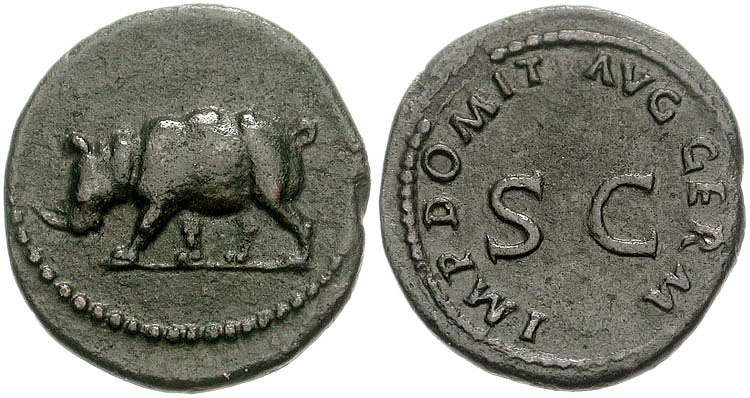
Imagery
Images were made on coins by striking the coin by hand onto a pre-cut die placed below (obverse) and above (reverse) the blank coin. In the Republic, control of state coinage was in the hands of three junior magistrates (later to be four), the tresviri aere argento auro flando feriundo or a.a.a.f.f. They often signed their issues and initially favoured such classic images as Roma, Jupiter, Mars and Victory. In the second century BCE a series of coins depicted a quadriga or four-horse chariot but from c. 135 BCE the tresviri metales began to stamp references to their own family history, local landmarks, contemporary events and perhaps even their political allegiance. The representation of rulers was avoided, perhaps because on Greek coins this had been for kings and tyrants and so was not in accordance with the principles of a republic. Legends were in vertical or horizontal lines not curving around the edge and could continue on to the opposite side of the coin.
Imperial period coins typically have on the obverse side a portrait of the emperor - now in sole charge of the state treasury - usually in profile wearing either a radiant crown or crown of laurel leaves, or, more rarely, a member of the imperial family. Portraits could vary from an idealised to very realistic representation depending on particular emperors, the stage of their reign and changing artistic trends. After Constantine imperial portraits became increasingly standardised and a more uniform representation of the emperor regardless of individual physical characteristics became the norm. A notable exception to using the emperor was the SC (Senatus Consulto) stamped on Augustan coppers, perhaps signifying senatorial backing. Legends now ran clockwise around the coin, always starting from the bottom left.
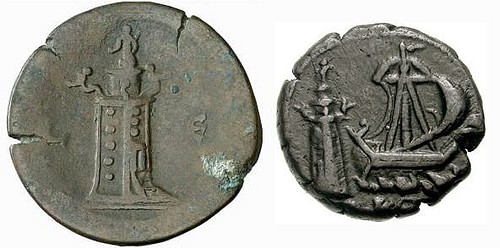
The reverse side of coins could carry a greater variety of designs and, in particular, Augustus' introduction of the large sestertius gave engravers a bigger scene to work with. Early bronze coins often depicted a ship's prow but higher value coins displayed much more interesting subjects and designs included monuments such as the Colosseum, Trajan's column, and various temples in Rome or state-sponsored projects such as aqueducts, bridges and the revamped harbour of Ostia depicted on Nero's sestertii. Imperial conquest could be referenced such as Augustus' use of a crocodile chained to a palm tree on as coins to symbolise the subjugation of Egypt. Mark Anthony's coins carried the numbers of the particular legions they were destined for, and provincial coins could depict local gods and heroes, monuments and even symbols of local religion such as the canopic jars on the reverse of coins minted in Alexandria.
Conclusion
In many cases, coins offer the only physical likeness of prominent personalities in the history of Rome. They also depict lost or ruined monuments and help to establish both the precise chronology of Rome and the date of other artefacts that might accompany them in archaeological finds. Coins of certain date can also help to date other less certain coins when they are found together. Coin portraits have also contributed invaluably to naming previously unidentified portrait sculpture and the distribution of coins across the empire can also reveal much about population movements, trade networks and civic identity. All of these studies continue to develop over time as ever more coin hoards are randomly discovered in out of the way places across territory once part of the Roman Empire.
